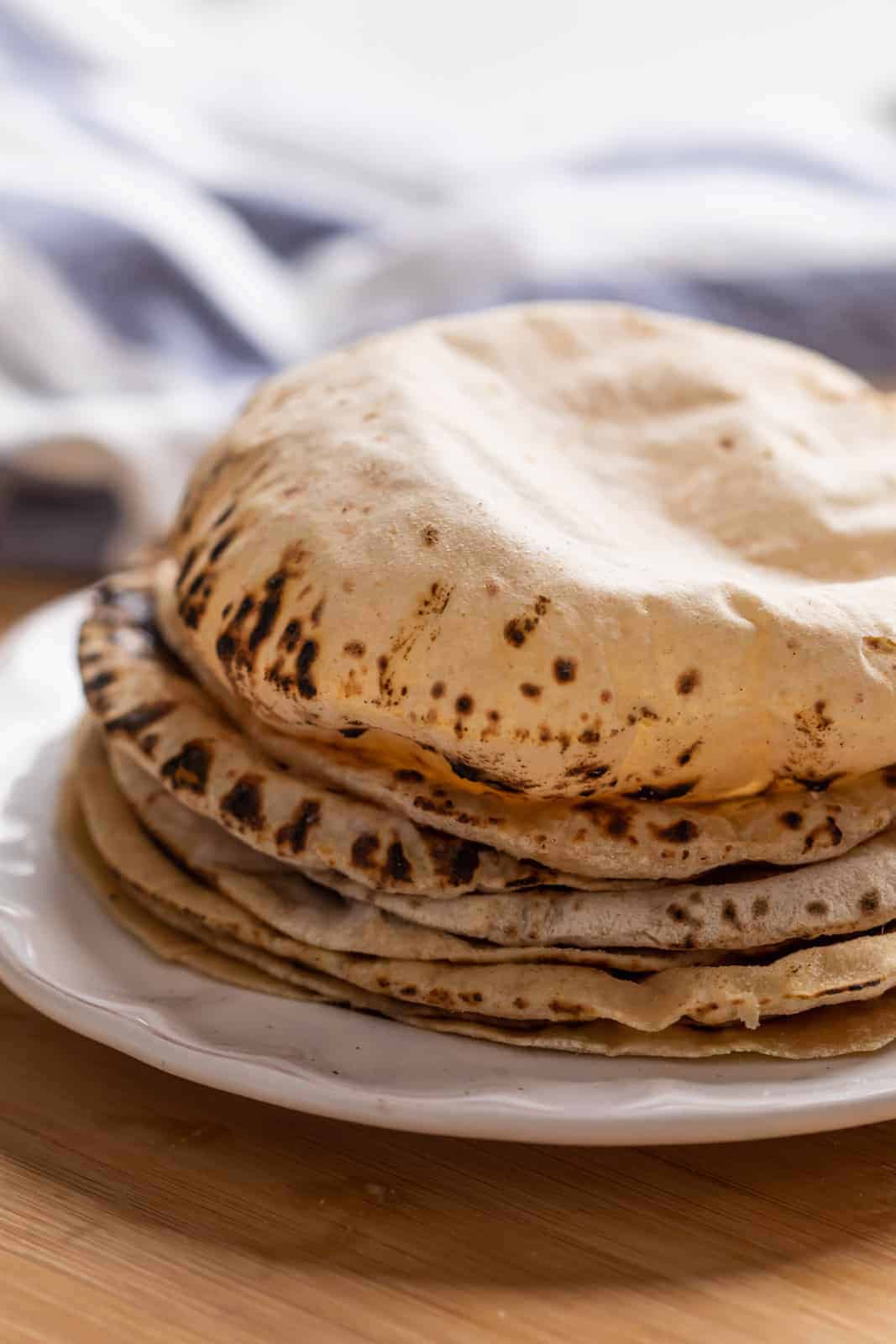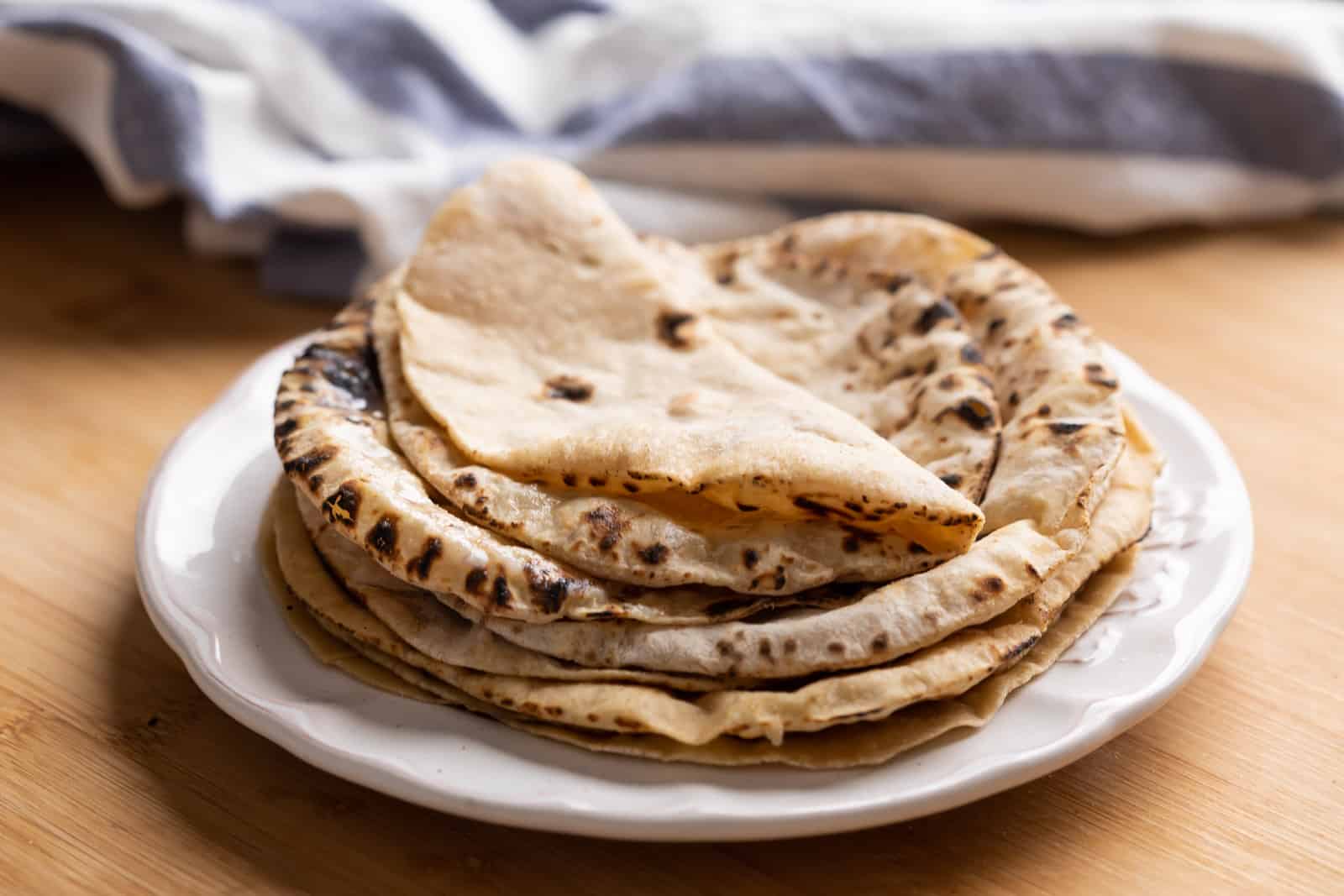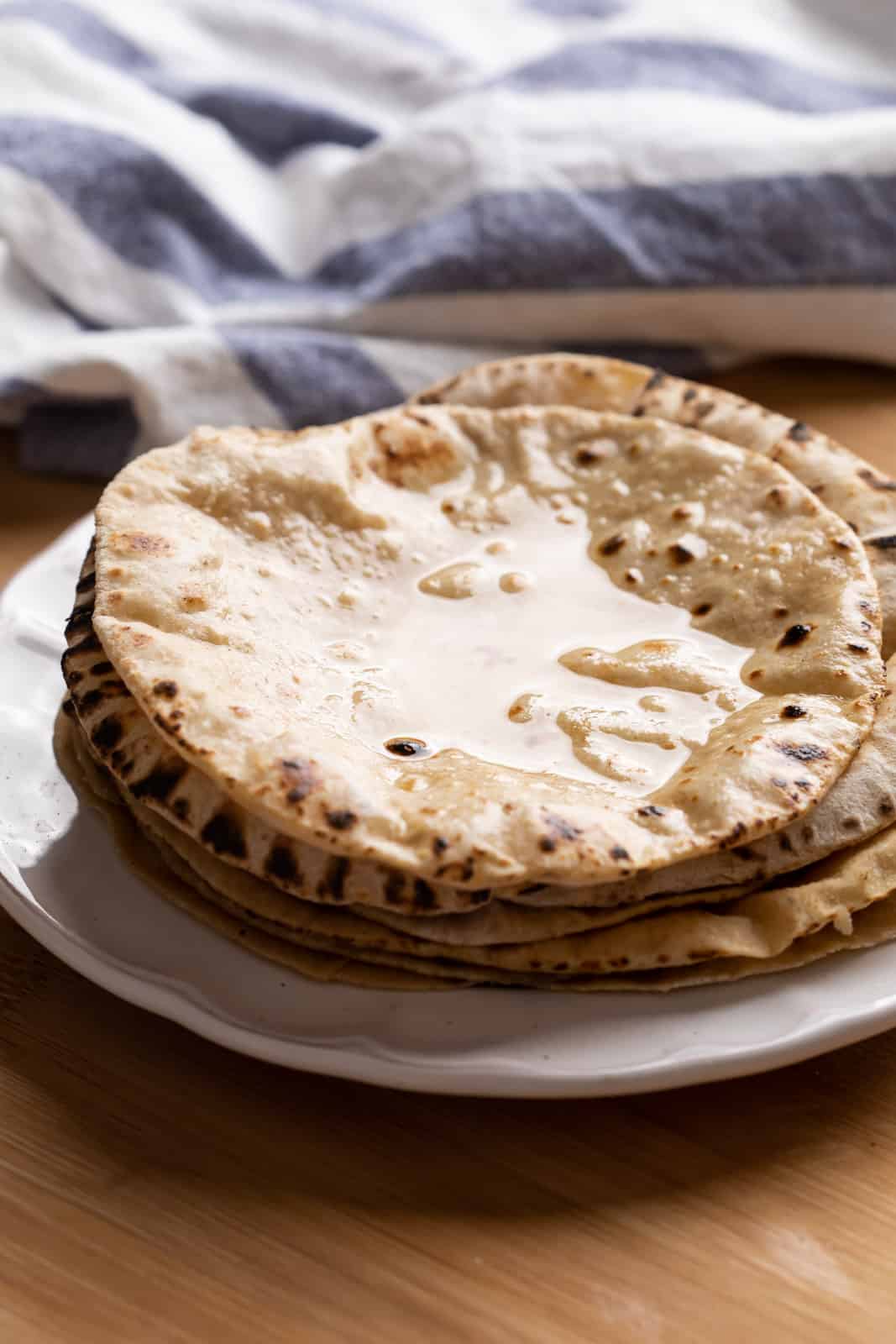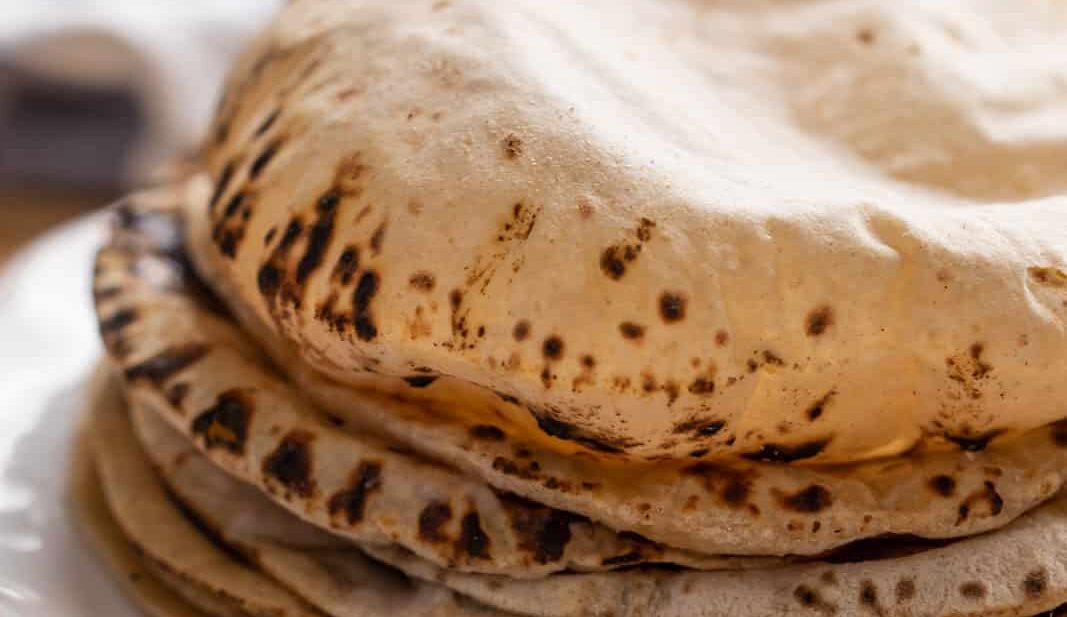I've grown up eating soft rotis and here's my guide to making them at home. Also called chapatis / phulkas / rotli, these two ingredients Indian flatbreads are magical because they are fast, easy and so satisfying.
Yes, I said it. I think rotis are magical. Because they are made with one ingredient - wholemeal wheat flour (atta) and water if that counts as an ingredient. You don't need any leavening agents like yeast or baking soda or even yogurt. All you need is some practice and patience.

Growing up, we had rotis every single day so I would like to think that I have a fair experience in everything rotis. And that's what I'm sharing today - everything I know about making soft rotis at home. Lets go one by one.
Dough for Rotis
The dough for rotis or chapatis is made with two simple ingredients - wholemeal wheat flour or atta, and water. Some people add a pinch of salt (I do that sometimes), some add a little oil, but mostly, I prefer them without any of these. The rough estimates for flour to water is given in the recipe below.
Kneading the Dough
It's important that the dough is smooth, soft and pliable. This means that when you press down on the dough, you don't face too much resistance, and when you press it with your fingers, it should leave an indentation. The dough should not be sticky or too dry. It should feel smooth to touch. Once you mix the flour and water, knead using your knuckles and palm. Stretch the dough with your palms, bring it back with your fingers, knead with your knuckles and repeat till it feels soft.
Water in the dough
Water in this dough plays a really important role. It created steam when the rolled out rotis are placed on heat and that's what makes them puff up. How cool is that. So I like to add a few extra drops of water as I knead and keep kneading for a while. The atta (flour) keeps absorbing the water. So the more water you can integrate into the dough without it becoming sticky, the better it is.
Resting the dough
Over time I've realised that while resting the dough is not critical to making good rotis, it's definitely helpful. Resting the dough does just that - it helps the dough come together, smoothen out even further and helps the dough become more pliable, easier to roll, and produces softer rotis.

Rolling out rotis
This might be the tricky part and honestly this comes with practice and patience. In the beginning, don't get hung up on the shape of the rotis. As long as they are somewhat circular, you are good to go. A small lime sized ball is enough, make sure its smooth and round as you start (watch the video for this), and then roll them out gently with a rolling pin. Too much pressure and your roti might tear and too little pressure and your roti might not flatten out evenly.
Cooking Soft Rotis
Start on a hot tawa or skillet when you cook them. If your skillet is not hot enough, the rotis will take too long to cook and this will dry them out. You start rotis on a tawa, and finish them on an open flame to puff them up. If you don't have an open flame, you can press down gently with a cloth along the sides and they will start to puff up on the skillet.
I like to finish off hot rotis by smearing them with ghee. I can't have rotis without it. If you don't have ghee, you can make some at home with my homemade ghee recipe. And if that's not possible, just smear them with some butter.

I have a FAQ below the recipe card that you can refer to, which has answers to more questions.
But most importantly, remember - making soft rotis at home takes some practice and patience. A few tries, and you'll be making them like a pro!
Rotis are best enjoyed with
How to make soft rotis at home recipe video

Soft Rotis - How to make them at home
Ingredients
- 2 ½ cups Atta / Wholemeal Wheat Flour set aside ¼ cup flour for dusting
- ¾ cup Water lukewarm (approx)
- 1-2 teaspoon Ghee to smear on rotis
Instructions
- To make the dough, place the flour in the center of a wide mouthed bowl or a plate with a high rim. Make a well in the center and add ¼ cup water. With your fingers, mix the water and flour together; add another ¼ cup water and mix. Do the same thing again till the dough starts to roughly come together. If the dough is too dry, add a teaspoon of water at a time. Once the dough comes together, start kneading the dough, alternating between your palms and your knuckles. Press it down with your palm, pull it with your fingers and then pull it back. Use your knuckles to press down on the dough, making indentations and repeat till the dough is soft and pliable. This should take 3-4 minutes. I like adding a few drops of water and kneading and i repeat this process 2-3 times.
- Once the dough is ready, cover it with a barely damp cloth and rest it for 15-20 minutes.
- While you roll the dough, put a tava on the stove and let it pre-heat. To roll the dough, take a small lime sized piece of dough and smoothen it into a ball between your palms. Place it on a rolling board or the kitchen counter and gently press it down to flatten it. Now dust the dough gently with dry atta and start rolling it. Move the rolling pin along the length, pressing gently as you go. If your roti feels sticky at any point, dust it with some dry flour. Keep rotating the roti in a circular motion and rolling till its approx 5-5.5 inches in diameter and is evenly rolled out.
- Make sure the tawa or skillet has heated evenly before you start cooking rotis. It should be hot, but not smoking. Place the roti in the center of the tawa. Wait till you see bubbles on the surface. Once the bubbles form, flip the roti. Once you see bubbles on the other side, use a pair of tongs to flip again and transfer the roti to an open flame. In less than 5 seconds, you'll start to see the roti puff up. Flip again to cook the other side, and remove from the heat. If your roti doesn't puff up, don't worry, just cook it till you see brown spots.
- While they are still hot, smear the rotis with ghee so that it melts. Stack them one on top of the other. The residual heat, keeps them soft, and prevents them from drying out.
- Make sure the tawa or skillet has heated evenly before you start cooking rotis. It should be hot, but not smoking. Place the roti in the center of the tawa. Wait till you see bubbles on the surface. Once the bubbles form, flip the roti. Once the bubble form on this side, take a soft cloth or towel and start pressing down lightly on the roti, rotating it as you go. It will start puffing up as you press. Roti is cooked when you see light brown spots on both sides. Smear it with ghee or butter while it's still hot, and serve immediately.
Video
Notes
- Water: Different brands of water soak up different amounts of water. Increase or reduce the water by a tablespoon or two if required
- Storing the dough: The dough can be stored in an airtight container in the fridge for up to two days. The colour might darken slightly, but that doesn't mean the dough is spoiled. Don't use the dough if it starts to smell sour.
- Substitutes for water: The dough can also be kneaded with milk, whey or vegetable stock. Different people prefer different liquid for kneading.
- Multigrain Atta: Using multigrain atta might result in crisper, slightly denser rotis that may not be as soft. Plain, whole wheat flour produces the softest rotis
- Freezing rotis: Plain rotis (without ghee) can be frozen up to 3 months by stacking them on top of the other with a layer of parchment paper in between them. I've detailed this process below the recipe card.
- Storing cooked rotis: Cooked rotis, smeared with ghee, can be stored, wrapped in a soft cloth or aluminium foil outside for a day. I prefer storing them in an airtight container on the kitchen counter. We even snack on them during the day.
Nutrition
Frequently Asked Questions about making Chapatis
Difference between rotis and chapatis: These are mainly different names for the same thing. Up north these are called rotis, down south people prefer chapati, in Gujarat they are called phulkas or rotlis.
Are rotis healthy: Rotis are a great source of fiber and when consumed with dal and sabzi, they make a wholesome meal
Why do rotis become hard? Rotis can become hard if they haven't been kneaded with enough water, and the dough isn't soft and pliable to start with. Another reason for them becoming hard is if the tava or skillet wasn't hot enough to start with.
Why don't my rotis puff up? Puffed up rotis take practice and patience. A few reasons could be that the dough wasn't soft, the tava wasn't hot enough, or they weren't rolled out evenly and had thick and thin spots. But seriously, keep trying and soon enough, you'll be making beautiful rotis. Its a skill once learned, will last you a lifetime.
How to freeze rotis or chapatis: Rotis or chapatis can be easily frozen. Cook them, and then stack them one on top of the other with parchment paper between each roti - this helps them from sticking to each other. To freeze rotis, make sure to use rotis without ghee. I prefer making stacks of 6-8 so that they can be defrosted for a single meal. Once you have a stack, wrap it in a foil, place it in a ziplock and place it flat in the freezer. After a few hours, once the rotis are frozen you can move it around your freezer. To defrost, place the foil wrapped rotis in the fridge overnight and heat them on the tava. Or you could take them out of foil, and microwave them for a few minutes.


Heather Krenzer says
As a kansas girl, I had never had indian cuisine until I moved to the Seattle area and I have fallen in love with it. I've always loved cooking and I have learned to make many amazing curries. I hate tried making roti time and time again with failure so stopped trying for about 3 years. Decided to take it on again using your recipe and video and THEY TURNED OUT! Thank you so much!!!
Richa Gupta says
That's so lovely to hear, Heather! We are thrilled that you like Indian cuisine! Stay tuned for more exciting Indian recipes!
Tripti Mehra says
Perfect manner to tell how to Make Roties Ma'am
Chase says
Me and my kids made these today and oh my heck they were perfect!!!
I’m so happy I found your blog!
Richa Gupta says
Aww, that's so sweet! Thank you and happy cooking! 🙂
Neda says
U explained it in the most honnest way possible
Richa says
Thank you!
Nayana says
Hi Richa...
Thanks for such a detailed recipe
I have a query.. My rotis have deep brown spots on both sides and are soft. However parts of it still remain kaccha.. Where could I be going wrong..
Richa says
Hey Nayana, was your tava hot when you put the roti on it? Rotis can remain kachha if it doesn't start cooking evenly on the tava which happens if the tava isn't hot enough
Crystal says
My mother-in-law has been trying to teach me how to make these off and on for years. I am from the states and she is from Pakistan and doesn’t speak English so it has been frustrating for her to deal with me. Lol This recipe is exactly what she has shown me but mine always come out too hard and when I ask she tries to tell me but I cannot totally understand what she is saying. (I am learning) Thank you for posting this as now I can practice in secret and surprise everyone once I figure it out. I am sure she will be grateful to have someone else to make these so she can rest as she deserves.
Richa Gupta says
This is such a cute story, Crystal! Hope you nailed the art of roti-making and surprised your folks!! Happy cooking 🙂
Dolly Jain says
Lovely way you taught it
Richa says
Thanks for leaving a comment! Soooo glad you liked it Dolly
Kim says
Chapattis sound so basic in Indian households but it takes a lot of practise and can be quiet technical.
I love the way you have explained each technical aspect right from the role of water and touched on points that many you tube videos don’t explain! Really shows your passion for food.
Great video and you have such a sweet smile 🙂
Richa says
Thank you so much Kim. I'm glad you found this helpful
SM says
2 1/2 cups Atta / Wholemeal Wheat Flour set aside 1/4 cup flour for dusting
Hi.You’re a breath of fresh air :). I have a question. The 1/4 cup flour for dusting is separate from the 2 1/2 cups of atta used for kneading right?
Richa Gupta says
That's right, Seema!
m.jayaram says
madam, Namasthe!
It is not the issue how you made chapathis as I see
but the way you explained how to make them with such
sweet way as though you are our family member it is worth
to put on the comment.
I wish you and your family a happy situations every moment
and pleasant life ever!
Richa says
Thank you so much Jayaram!
Anu says
I tried this method and my rotis came out so soft and perfect! I always struggled with making perfect, soft rotis. Thanks, Richa, for sharing this method.
Shreya Thakur says
Very nicely explained, thank you. Good job .☺
Mahesh j says
Simple easy to learn
Richa says
Thank you Mahesh!
aydın says
I enter your website regularly almost every day. You have some great articles. I Love Your Suggestions. Thanks.
Ghulam Mohyudin says
Good to know that works too! I learn so much from you as well! Keep it up great post.